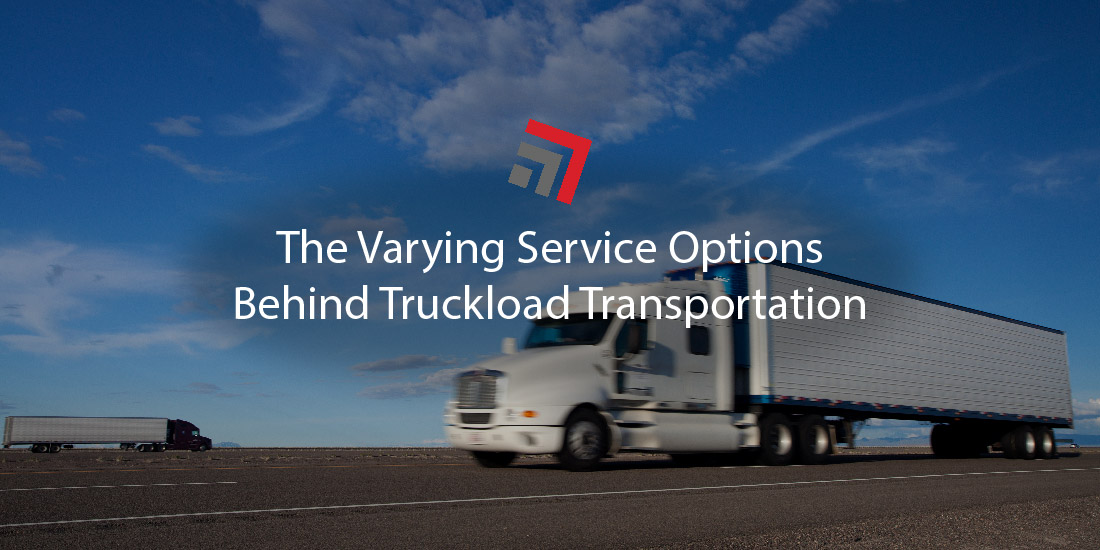Is the service definition behind domestic (non-intermodal) transportation simply by way of truck?
Technically speaking, yes. Truckload is the dominant mode of transport in the industry, with thousands of fleets dispatched every hour. However, the process of hauling loads is not as simple as cramming cargoes into a van trailer and sending them off to their destination.
In the realm of trucking, there exists distinct service options that trucking companies offer and shippers can choose from akin to their unique service requirements.
Full Truckload
As its title suggests, full truckload (FTL) transportation commits the entire capacity of a truck’s trailer for a single shipment. This type of mode is beneficial to shippers who must move a larger volume and cannot share space with freight from other shippers.
Since FTL shipments are direct, transit times are typically the fastest of trucking’s service options. That said however, FTL is also usually the most expensive as it requires exclusive use of an entire truck and trailer for one single shipment. Though, for shippers with enough volume to fill a trailer completely, the service option is cost-effective.
The other advantage is to FTL shipping is security. Once a shipment is loaded at its pickup point, the goods are rarely unsealed or moved until they reach their destination. This also means there is less handling in the shipping process, reducing the possibility of damage or loss to the shipment.
In most cases, shippers with smaller load requirements should not use FTL. If they do not possess enough freight to occupy an entire trailer, they would end up having to pay a higher cost per unit as the carrier would still bill a full rate even if there is unused space. Instead, these shippers should consider the next option listed below.
Learn more about full truckload shipping!
Less-Than-Truckload (LTL)
Less-than-truckload (LTL) shipping can be understood as the reverse to FTL. The service option is best for shippers moving an amount of goods that do not require the space of an entire trailer. Since these are smaller shipments, a truck hauling an LTL load typically has several, separate, shipments onboard. Shipments are generally arranged on pallets and can range anywhere from 100 pounds to 10,000 pounds. Shippers with smaller loads prefer the LTL model because it provides them flexibility and cost savings.
Unlike FTL, which runs a single shipment directly between two points, LTL shipping combines several loads to create full multi-stop truckloads. Shippers are charged based on the amount of space they use, the class of items being shipped, and pickup/destination locations.
The service option presents cost savings for shippers with smaller loads that would otherwise suffer from higher FTL pricing for unnecessary space. Essentially, they only pay for the space they use. Depending on the shipment, the costs are likely to be significantly lower than that of an FTL service.
That said, while the model is a cheaper alternative, LTL shipping does not boast the one-stop expedience which FTL advertises. As mentioned, the service option combines multiple shipments from separate shippers into one full load. This means that the truck will have to stop at multiple destinations to unload each shipment. As a result, transit times are generally longer, a reality shippers must account for.
Unless shippers have significant LTL volume, they are advised to use LTL freight consolidators, logistics providers which collect smaller shipments from several shippers and combine them to form full truckloads at their consolidation centers. The use of consolidators leads to increased efficiency and savings.
Learn more about less-than-truckload shipping!
Partial Truckload
Partial truckload shipping meets somewhere in the middle between FTL and LTL shipping. The service option is intended for larger shipments that may not require the entirety of a trailer (full truckload). These shipments usually involve four or more pallets and weigh over 5,000 pounds.
An important distinction between LTL and partial loads is that the latter does not require a freight class in order to secure a rate. They also experience less handling, resulting in faster transit times. That said, the service option still operates similarly to LTL, as logistics professionals often refer to the mode as “volume LTL”.
Partial truckload is the best option for shippers with volume requirements that toe the line between LTL and FTL.
For starters, partial load shipping allows a shipment to stay on one truck for the duration of transit. In return, the freight is loaded and unloaded only one time, meaning less handling and faster transit times than LTL. Less handling also reduces the risk of damage or loss to a shipment.
The omission of a freight class requirement also helps partial load shippers avoid penalties in the event of having to re-classify their freight if they had filed incorrectly. An otherwise unfortunate snafu for LTL shippers, who would be charged.
That said, shippers are advised to choose partial over LTL if their shipment exceeds 5,000 pounds or requires four or more pallets. At this volume or greater, the service option is likely a more cost-effective option to LTL. The type of freight being shipped is also important when deciding between the two modes. For example, if the freight in question is low density (light but takes up a lot of space) or fragile (prone to damage from handling), partial load shipping would be the preferred practice.
Costs for partial load service are also an attractive proposition to some. Like LTL, shippers pay for the space they use, but, unique to itself, also for the weight of the shipment.
Learn more about partial truckload shipping!
Final Thoughts
Each of these service options has unique benefits and potential drawbacks. Depending on the volume, preferences, and timelines of a shipper, one may be more advantageous than the others.
If you are curious about the best course of action regarding your situation, contact our team at Commerce Express to learn more about the best practices of truckload shipping.
More blogs similar to this:



Recent Comments